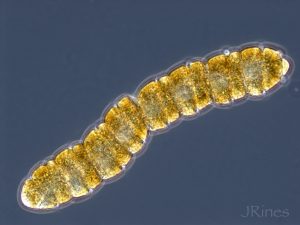by Ted Smayda

The streaks and patches of rust-red water in Narragansett Bay and some coastal ponds the past month is because of a bloom of the planktonic, micro-alga Cochlodinium polykrikoides, a member of the phytoplankton. The phytoplankton harvest light energy and nutrients, and through their photosynthesis grow and bloom in the sea, serving as the basic food source sustaining marine food webs. In recent decades, some phytoplankton species increasingly began to form harmful blooms affecting seafood safety, shellfish aquacuture, farmed fish survival, aquaculture revenue and disrupt natural food webs. Cochlodinium polykrikoides is such a species, and one currently undergoing an aggressive, major global expansion into new habitats. Its harmful character comes from its secretion of chemical substances and sticky, gelatinous substances that attach to fish gills, both of which can lead to fish kills, particularly caged farm fish. The Cochlodinium bloom in Narragansett Bay is a regional event, stretching westwards from Buzzards Bay, Peconic Bay, where intense blooms began in July, into Narragansett Bay and some coastal salt ponds. While its sudden, prolonged local blooming is unusual, it has bloomed previously in lesser intensity and duration in the Narrow River and Pt. Judith Pond. The causes of Cochlodinium’s global expansion and intense coastal and local blooms are unknown. Nutrient enrichment and warming of coastal waters have been invoked, but there are harmful species-specific exceptions to such stimulation. Countermeasures to control its blooms are limited to broadcasting special sand mixtures to agglutinate Cochlodinium cells in order to induce their sinking from caged fish farm deployments and thereby reduce its ichthyotoxic threat. Otherwise, once in progress the bloom will continue until whatever stimulant inducing it to bloom is no longer operative.
The sobering aspect of the Cochlodinium bloom in Narragansett Bay is it adds to the approximately 15 indigenous harmful species, widening harmful species niches accompanying bay warming. Harmful blooms and red tides in Narragansett Bay are not as common as in some other New England localities, but this may be changing. Since the six month “brown tide” in 1985, when most of the mussel population died off, an increasing number of species harmful within its distribution have been found in Narragansett Bay with the potential of forming harmful blooms, including species that cause shellfish-borne gastrointestinal illness, paralytic shellfish poisoning and fish kills. This increasing threat is worrisome given the growing importance of aquaculture in Narragansett Bay.
The consumption of shellfish and finfish harvested locally, swimming and boating in Naragansett Bay during the Cochlodinium bloom are without human risk.
